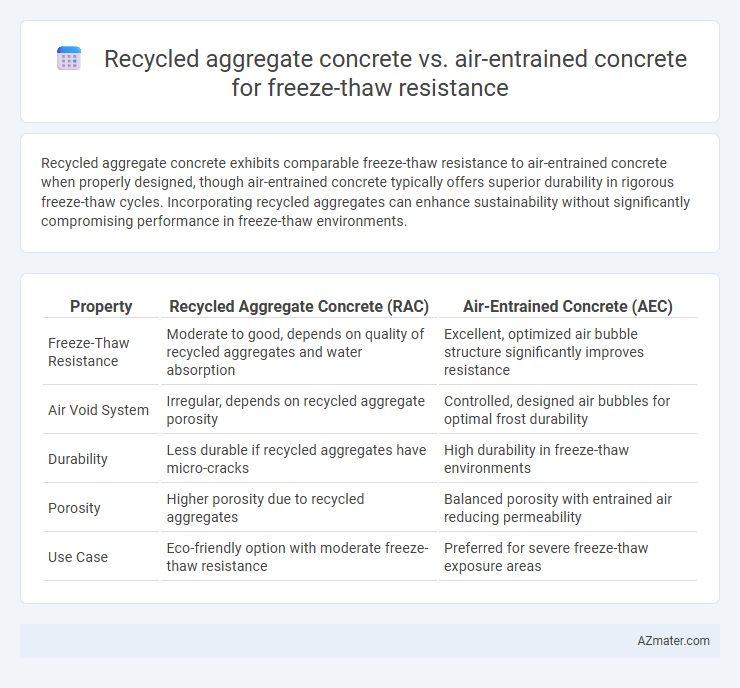Recycled aggregate concrete exhibits comparable freeze-thaw resistance to air-entrained concrete when properly designed, though air-entrained concrete typically offers superior durability in rigorous freeze-thaw cycles. Incorporating recycled aggregates can enhance sustainability without significantly compromising performance in freeze-thaw environments.
Table of Comparison
| Property | Recycled Aggregate Concrete (RAC) | Air-Entrained Concrete (AEC) |
|---|---|---|
| Freeze-Thaw Resistance | Moderate to good, depends on quality of recycled aggregates and water absorption | Excellent, optimized air bubble structure significantly improves resistance |
| Air Void System | Irregular, depends on recycled aggregate porosity | Controlled, designed air bubbles for optimal frost durability |
| Durability | Less durable if recycled aggregates have micro-cracks | High durability in freeze-thaw environments |
| Porosity | Higher porosity due to recycled aggregates | Balanced porosity with entrained air reducing permeability |
| Use Case | Eco-friendly option with moderate freeze-thaw resistance | Preferred for severe freeze-thaw exposure areas |
Introduction to Freeze-Thaw Resistance in Concrete
Freeze-thaw resistance in concrete is crucial for durability in climates with frequent temperature fluctuations. Recycled aggregate concrete (RAC) incorporates crushed concrete waste, affecting porosity and potentially reducing freeze-thaw resistance compared to traditional mixes. Air-entrained concrete contains microscopic air bubbles that relieve internal pressure, significantly enhancing freeze-thaw durability by preventing cracking and scaling.
Understanding Recycled Aggregate Concrete
Recycled aggregate concrete (RAC) incorporates crushed concrete waste, offering sustainability benefits but posing challenges in freeze-thaw resistance due to higher porosity and water absorption compared to natural aggregates. The porous nature of recycled aggregates can lead to increased internal moisture retention, which exacerbates freeze-thaw damage unless properly treated or supplemented with air-entraining agents. Optimizing mix design and incorporating air-entraining admixtures improve the durability of RAC by enhancing resistance to freeze-thaw cycles, bridging the performance gap with conventional air-entrained concrete.
What is Air-Entrained Concrete?
Air-entrained concrete contains microscopic air bubbles intentionally introduced through air-entraining agents, enhancing its freeze-thaw resistance by providing space for water expansion during freezing. This property significantly reduces internal stress and prevents cracking in climates with frequent freeze-thaw cycles. Compared to recycled aggregate concrete, air-entrained concrete offers superior durability and longevity in such environments due to its improved pore structure and water management.
Mechanisms of Freeze-Thaw Damage
Recycled aggregate concrete demonstrates increased porosity due to old mortar attached to the aggregates, which can enhance freeze-thaw resistance by providing additional space for ice expansion, thus reducing internal stress. Air-entrained concrete introduces microscopic air bubbles that act as pressure relief chambers, significantly minimizing freeze-thaw damage by preventing microcracking caused by ice formation within the concrete matrix. The key mechanisms of freeze-thaw damage involve hydraulic pressure from water freezing in pores and crystallization pressure, both mitigated more effectively by controlled air entrainment than by the natural porosity of recycled aggregates.
Comparative Performance in Freeze-Thaw Cycles
Recycled aggregate concrete typically exhibits lower freeze-thaw resistance compared to air-entrained concrete due to the higher porosity and water absorption of recycled aggregates, which increase internal stresses during freezing. Air-entrained concrete incorporates microscopic air bubbles that provide critical space for ice expansion, significantly enhancing durability through multiple freeze-thaw cycles. Studies indicate that air-entrained concrete maintains structural integrity and prevents surface scaling more effectively than recycled aggregate concrete under identical freeze-thaw testing conditions.
Influence of Aggregates on Durability
Recycled aggregate concrete (RAC) demonstrates variable freeze-thaw resistance depending on the quality and type of recycled aggregates used, as porous and weaker aggregates can increase water absorption and reduce durability. Air-entrained concrete (AEC) incorporates microscopic air bubbles that alleviate internal pressure during freeze-thaw cycles, significantly enhancing resistance by preventing microcracking. The aggregate's characteristics critically influence durability, with well-graded, low-absorption aggregates in RAC improving performance, while air entrainment provides a more consistent and reliable mechanism for freeze-thaw protection across various aggregate types.
Role of Air Entrainment in Concrete Longevity
Air entrainment introduces microscopic air bubbles into concrete, significantly enhancing freeze-thaw resistance by providing space for ice expansion and preventing internal cracking. Recycled aggregate concrete often exhibits reduced freeze-thaw durability due to inherent porosity and weaker aggregate-cement bonds, but proper air entrainment can mitigate these vulnerabilities and improve longevity. Studies indicate that optimized air entrainment in recycled aggregate concrete achieves durability comparable to conventional air-entrained concrete, making it a viable sustainable alternative for cold climates.
Environmental Impact and Sustainability Considerations
Recycled aggregate concrete significantly reduces environmental impact by repurposing construction waste, lowering the demand for virgin materials and minimizing landfill use. Air-entrained concrete enhances freeze-thaw resistance through microscopic air bubbles that prevent internal cracking but relies on conventional aggregates, resulting in a higher carbon footprint compared to recycled alternatives. Incorporating recycled aggregates promotes sustainability by conserving natural resources and reducing greenhouse gas emissions, making it a greener choice for freeze-thaw resilient structures.
Best Practices for Enhancing Freeze-Thaw Resistance
Recycled aggregate concrete (RAC) improves freeze-thaw resistance by incorporating well-graded recycled aggregates and adding supplementary cementitious materials like fly ash or silica fume to reduce permeability and enhance matrix density. Air-entrained concrete enhances durability through the deliberate inclusion of microscopic air bubbles, which provide internal spacing to accommodate freezing water expansion and mitigate cracking. Combining optimized air-entrainment techniques with proper curing practices and low water-cement ratios delivers superior freeze-thaw resistance in both recycled and conventional concrete mixtures.
Conclusion: Choosing the Optimal Concrete for Freeze-Thaw Environments
Recycled aggregate concrete demonstrates competitive freeze-thaw resistance when properly designed with adequate air void systems, offering sustainable alternatives with reduced environmental impact. Air-entrained concrete remains the industry standard for superior durability against freeze-thaw cycles due to its controlled air void structure that effectively mitigates internal stress. Selecting optimal concrete depends on balancing environmental goals with required durability, making air-entrained concrete preferable in severe conditions, while recycled aggregate concrete suits moderate freeze-thaw exposures with sustainability benefits.

Infographic: Recycled aggregate concrete vs Air-entrained concrete for Freeze-thaw Resistance
 azmater.com
azmater.com